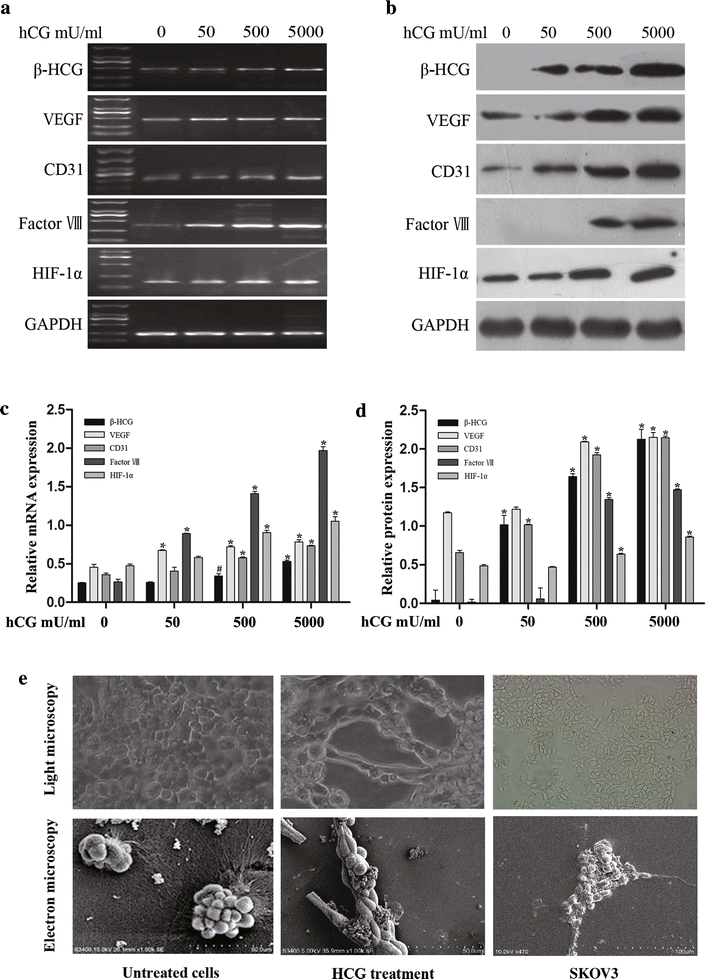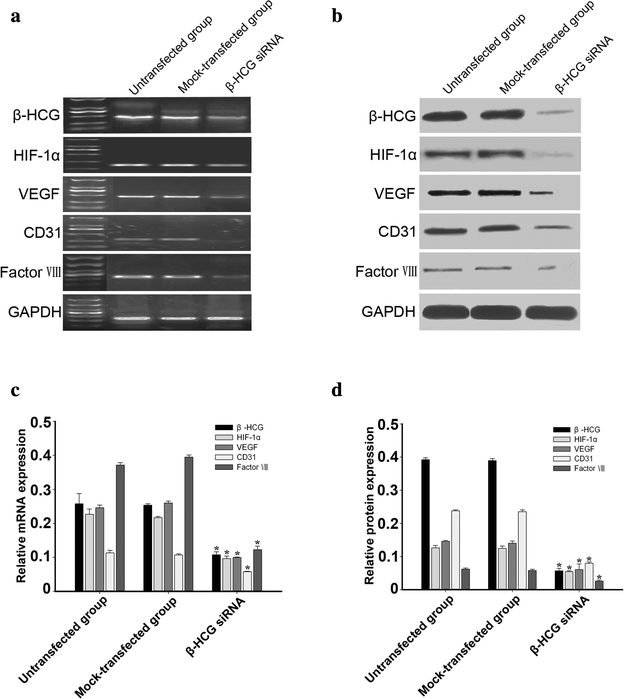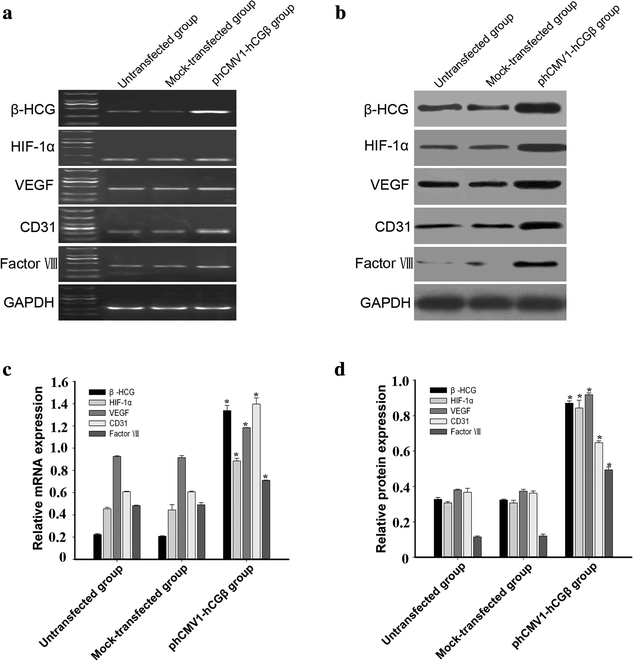Involvement of human chorionic gonadotropin in regulating vasculogenic mimicry and hypoxia-inducible factor-1α expression in ovarian cancer cells
- PMID: 27346985
- PMCID: PMC4919850
- DOI: 10.1186/s12935-016-0327-0
Involvement of human chorionic gonadotropin in regulating vasculogenic mimicry and hypoxia-inducible factor-1α expression in ovarian cancer cells
Abstract
Background: Human chorionic gonadotropin (hCG) can play a crucial role in angiogenesis. In the present study, we focused on hCG to gain insight into its potential effects on vasculogenic mimicry (VM) in ovarian cancer cells.
Methods: Ovarian cancer OVCAR-3 cells were incubated with different concentrations of recombinant hCG in 3-dimensional cultures. VM was identified by morphological observations and vascular endothelial cell marker detection in OVCAR-3 cells. Expression of hCG, hypoxia-inducible factor-1α (HIF-1α), and the endothelial cell markers CD31, VEGF, and factor VIII were detected by reverse transcription polymerase chain reaction and western blotting. The effect of hCG on endothelial cell-marker expression in ovarian cancer cells was further explored using small interfering RNA (siRNA) and plasmid-based approaches.
Results: Incubation of OVCAR-3 cells with recombinant hCG induced vessel-like network formation, which was accompanied by significant elevation of vascular marker expression. Attenuation of hCG expression by siRNA in OVCAR-3 cells suppressed the expression of endothelial cell markers and HIF-1α by tumour cells. Overexpression of hCG in OVCAR-3 cells resulted in increased expression of endothelial cell markers and HIF-1α.
Conclusions: HCG was crucial for changing the phenotype of OVCAR-3 cells to endothelial-like cells. The effect of hCG induction on VM in ovarian cancer cells is potentially associated with HIF-1α.
Keywords: Human chorionic gonadotropin; Hypoxia inducible factor-1α; Ovarian cancer; Vasculogenic mimicry.
Figures




Similar articles
-
Role of hCG in vasculogenic mimicry in OVCAR-3 ovarian cancer cell line.Int J Gynecol Cancer. 2011 Nov;21(8):1366-74. doi: 10.1097/IGC.0b013e31822c7529. Int J Gynecol Cancer. 2011. PMID: 22027746
-
An HCG-rich microenvironment contributes to ovarian cancer cell differentiation into endothelioid cells in a three-dimensional culture system.Oncol Rep. 2015 Nov;34(5):2395-402. doi: 10.3892/or.2015.4215. Epub 2015 Aug 20. Oncol Rep. 2015. PMID: 26479853
-
Effects of HCG on human epithelial ovarian cancer vasculogenic mimicry formation in vivo.Oncol Lett. 2016 Jul;12(1):459-466. doi: 10.3892/ol.2016.4630. Epub 2016 May 25. Oncol Lett. 2016. PMID: 27347165 Free PMC article.
-
Plasticity of ovarian cancer cell SKOV3ip and vasculogenic mimicry in vivo.Int J Gynecol Cancer. 2008 May-Jun;18(3):476-86. doi: 10.1111/j.1525-1438.2007.01034.x. Epub 2007 Jul 21. Int J Gynecol Cancer. 2008. PMID: 17645504
-
Activation of PI3K/mTOR signaling pathway contributes to induction of vascular endothelial growth factor by hCG in bovine developing luteal cells.Anim Reprod Sci. 2011 May;125(1-4):42-8. doi: 10.1016/j.anireprosci.2011.03.002. Epub 2011 Mar 15. Anim Reprod Sci. 2011. PMID: 21477953
Cited by
-
VEGFR2 regulates endothelial differentiation of colon cancer cells.BMC Cancer. 2017 Aug 30;17(1):593. doi: 10.1186/s12885-017-3578-9. BMC Cancer. 2017. PMID: 28854900 Free PMC article.
-
The transgenic expression of the β-subunit of human chorionic gonadotropin influences the growth of implanted tumor cells.Oncotarget. 2018 Oct 5;9(78):34670-34680. doi: 10.18632/oncotarget.26158. eCollection 2018 Oct 5. Oncotarget. 2018. PMID: 30410667 Free PMC article.
-
Mechanisms of Vasculogenic Mimicry in Ovarian Cancer.Front Oncol. 2019 Sep 27;9:998. doi: 10.3389/fonc.2019.00998. eCollection 2019. Front Oncol. 2019. PMID: 31612116 Free PMC article. Review.
-
TXNDC5 is a cervical tumor susceptibility gene that stimulates cell migration, vasculogenic mimicry and angiogenesis by down-regulating SERPINF1 and TRAF1 expression.Oncotarget. 2017 Jun 29;8(53):91009-91024. doi: 10.18632/oncotarget.18857. eCollection 2017 Oct 31. Oncotarget. 2017. PMID: 29207620 Free PMC article.
-
Regulation Networks Driving Vasculogenic Mimicry in Solid Tumors.Front Oncol. 2020 Jan 14;9:1419. doi: 10.3389/fonc.2019.01419. eCollection 2019. Front Oncol. 2020. PMID: 31993365 Free PMC article. Review.
References
-
- Yao LQ, Feng YJ, Ding JX, Jing HM, Xu CJ, Chen SF, et al. Differentiation of vascular endothelial cells-like derived from epithelial ovarian cancer cells induced by hypoxia. Int J Oncol. 2007;30:1069–1075. - PubMed
-
- Vartanian AA, Stepanova EV, Gutorov SL, Solomko ES, Grigorieva IN, Sokolova IN, et al. Prognostic significance of periodic acid-Schiff-positive patterns in clear cell renal cell carcinoma. Can J Urol. 2009;16:4726–4732. - PubMed
LinkOut - more resources
Full Text Sources
Other Literature Sources

